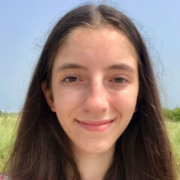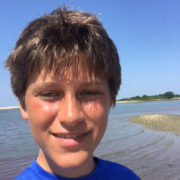 2020 Island Sentinels (l-r): Caroline Toldo, Nicolas Hall, Izzie Reid, Wilson Thors, Gardner Thors, Betsy Conger and Alexa Rosenberg. (Marc Rosenberg missing from picture.) Stephanie Hall Photo
2020 Island Sentinels (l-r): Caroline Toldo, Nicolas Hall, Izzie Reid, Wilson Thors, Gardner Thors, Betsy Conger and Alexa Rosenberg. (Marc Rosenberg missing from picture.) Stephanie Hall Photo
FIConservancy’s Island Sentinels program, established in 2014, provides environmentally passionate students from both Fishers Island School and the seasonal community the opportunity to observe and monitor flora, fauna, insects, marine life and birds across the Island. This experience, combined with discussion and guidance, is creating future stewards of our environment.

Betsy Conger, 18, lives in Stonington, Conn. She will be a freshman at Sewanee: The University of the South this fall and plans to major in Biology. She is an alumna of Fishers Island School, where she attended 6th-12th grade, commuting daily via ferry.
Betsy’s interest in environmental studies started in science classes, where teachers utilized the Island as a living laboratory. She was intrigued by the Island’s ecology and became an Island Sentinel to learn more about the environmental work taking place here. Betsy volunteered as a Sentinel in 2016 and 2017, before officially working as a Sentinel in 2018, helping to monitor ecological sites across the Island.
In the summer of 2018 and 2019, Betsy participated in the Sewanee Environmental Institute (SEI), where she learned about ecosystems, plant and animal species, archeological techniques, GPS and GIS technology and conservation strategies that she shared when she returned to the Island. She also learned the importance of caring for the environment, not just on Fishers Island, but globally, because all ecosystems are interconnected.
Betsy’s environmental stewardship extends beyond FIConservancy. As chair of the environmental committee for the East Lyme Leo Club chapter, an internationally recognized youth volunteer organization, she designed and organized the distribution of reusable grocery totes. Over 400 bags were distributed to shoreline residents.
 Nicolas Hall, 18, has lived on Fishers Island his whole life and is a sophomore at Dalhousie University in Halifax, Nova Scotia, where he is majoring in Oceanography. This is his third year as an Island Sentinel, including one winter of volunteering. Nick has a passion for the ocean whether sailing, fishing, spearfishing or simply going to the beach. He loves to monitor sites and immerse himself in Fishers flora and fauna. In addition to monitoring, Nick volunteers for the Fishers Island Seagrass Management Coalition helping them protect Fishers Island’s beautiful eelgrass meadows. Nick looks forward to furthering his knowledge and understanding of wildlife on and around the Island.
Nicolas Hall, 18, has lived on Fishers Island his whole life and is a sophomore at Dalhousie University in Halifax, Nova Scotia, where he is majoring in Oceanography. This is his third year as an Island Sentinel, including one winter of volunteering. Nick has a passion for the ocean whether sailing, fishing, spearfishing or simply going to the beach. He loves to monitor sites and immerse himself in Fishers flora and fauna. In addition to monitoring, Nick volunteers for the Fishers Island Seagrass Management Coalition helping them protect Fishers Island’s beautiful eelgrass meadows. Nick looks forward to furthering his knowledge and understanding of wildlife on and around the Island.

Isabelle “Izzie” Reid is a rising junior at Elon University majoring in Strategic Communications with a minor in Human Services. She is new to the Island Sentinels team this summer, but Fishers has been a part of her life for over 20 years. Isabelle went to Tabor Academy, where she studied Environmental Science, Oceanography, Fish & Fisheries. Her years by the sea instilled an appreciation for marine wildlife. Over the past couple months, Isabelle has enjoyed discovering more of our Island wildlife through the Island Sentinels and Seagrass Management Coalition programs and looks forward to exploring more of the Island!
 Alexa Rosenberg, 15, is a sophomore at Hunter College High School in New York City. She started as an Island Sentinel in the summer of 2019 and is very grateful for all the wonderful experiences she has had with the team. She has been coming to Fishers Island for as long as she can remember and has enjoyed learning about the fascinating Island wildlife. Alexa appreciates that the program has helped her to take a more active role in the protection and preservation of the Island.
Alexa Rosenberg, 15, is a sophomore at Hunter College High School in New York City. She started as an Island Sentinel in the summer of 2019 and is very grateful for all the wonderful experiences she has had with the team. She has been coming to Fishers Island for as long as she can remember and has enjoyed learning about the fascinating Island wildlife. Alexa appreciates that the program has helped her to take a more active role in the protection and preservation of the Island.

Marc Rosenberg, 16, lives in New York City and is a junior at Bronx High School of Science. 2018 was his “volunteer” year and first summer as an Island Sentinel. He joined the Sentinel program because he was interested in sea life and wildlife on Fishers Island.
Marc’s interest in sea life was sparked when he vacationed in Greece and observed a multitude of fish through his goggles. After that experience, Marc became increasingly curious about wildlife on and around Fishers Island. His trip to Costa Rica helped him experience more underwater life and renewed his passion for marine biology. This summer, Marc hopes to continue monitoring as well as working on monitoring water quality for the Fishers Island Seagrass Coalition.
Marc enjoys spending time under water and made a video of seagrass off the coast of Fishers Island. See Marc’s video.

Gardner Thors, 18, lives in New York City and is a freshman at Colgate University in Hamilton, New York. This is his seventh summer as an Island Sentinel, after volunteering for one summer. Throughout his childhood, growing up in the urban environment of Manhattan, Fishers Island has been his natural sanctuary. Gardner has been summering here for as long as he can remember, and Fishers holds a special place in his heart. That is why he chose to play a part in the preservation of this environment. With eight years of environmental preservation experience on the Island and schooling in ecology, conservation biology and other areas of environmental studies, Gardner looks forward to sharing his experiences and what he has learned with the Island community, as well as to continue to gather crucial data about the ever-changing ecology of Fishers Island. His brother, Wilson, is also a passionate Sentinel.

Wilson Thors lives in New York City and is a rising Junior at Groton School in Massachusetts. 2017 was his first summer as a Sentinel, although he volunteered to monitor for FIConservancy the year before. Initially, he joined the Island Sentinel program because he was curious about his brother’s experiences as a Sentinel and wanted to take an active role in supporting the environmental community of Fishers Island.
Through his two years as a Sentinel, Wilson has not only learned more about the ecological trajectory of Fishers Island, especially concerning the eelgrass meadows, but also how to direct it forward. Wilson has always appreciated the natural beauty of Fishers Island, but now he has a deeper love of the Island since learning more about the wildlife and learning that we share such a great Island with it.

Caroline Toldo is a third-year student at Loyola University Chicago, double majoring in Environmental Studies and Environmental Policy with a minor in Environmental Activism and Leadership. She lived on Fishers Island from the age of 12 and graduated from Fishers Island School in 2018. Caroline is looking to further educate herself on the humanitarian side of the ecological crisis, aiming to learn how to spread awareness. She is interested in furthering her education by getting a masters degree in Oceanographic Studies.
![]() Monarch butterfly at Parade Grounds. Laurie Marshall Photo
Monarch butterfly at Parade Grounds. Laurie Marshall Photo